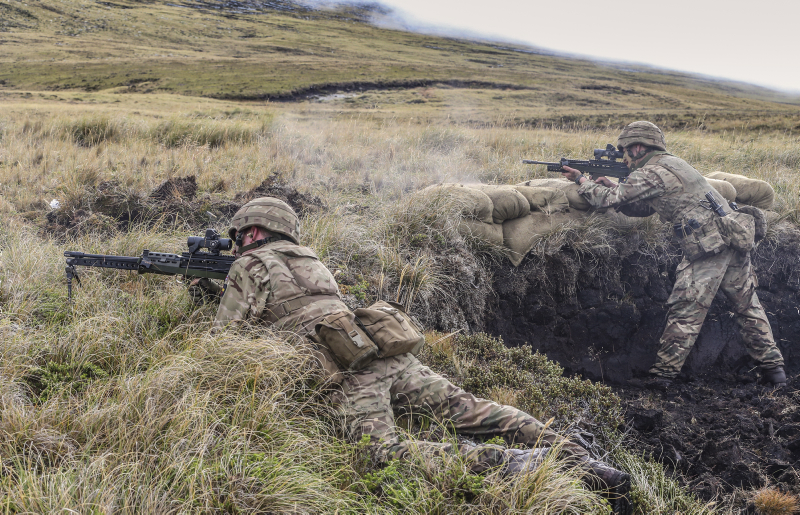



Sometimes the best cure for the hobby doldrums is a new project. My friend James deserves the credit and the blame here. We are both fans of the TV SF series The Expanse, based on the novels of James S.A. Corey, and that got James into an impressive 15mm SF gaming project. I have long admired James’ determination to bring a project to fruition - his contemporary Afghanistan project went from scratch to some very impressive, convention level games in a few years, and his SF efforts are similarly impressive. There is an example here, including some nicely written fluff.
Some of James’ UN (Earth) Marines in power armour, figures by Ground Zero Games. James’ project encompasses the Expanse universe, and I decided that I wanted a piece of that acton, but he seemed to have the various factions well represented. That led me to start thinking about an alien race, of which there are plenty in the various 15mm SF anger out there. But which one?

Kitties, of course!

Errr, no, not those kitties. My partner Joy introduced me to the Larry Niven Ringworld series this winter, and I loved the Kzinti character Speaker to Animals, so a race of martial cats seemed like a good choice, especially as James has (unkindly but aptly) accused me of being a Crazy Cat Chaplain. It seems a natural choice for trash-talking and chirping - I am sure there will be lots of jokes about distracting my force with laser pointers, catnip, and guided tuna missiles. I’m there for that.
Khurasan Miniatures does a nice line of 15mm SF felines, which they call Tigrids, so that was my Kzinti infantry sorted. I got several packs of these light infantry, who unlike James’ troops apparently don’t need or have vac suits, and then several packs of heavier infantry who I will call equivalent to James’ guys in power armour.
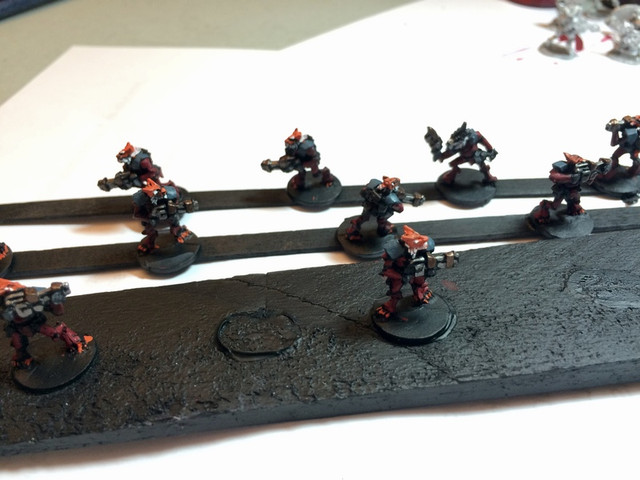
The paint scheme is pretty simple. Citadel flat back primer (my usual choice for 15mm figures) and the armour in GW Khorne Red, which seemed an appropriately bloodthirsty colour for Kzin. The red echoes the base colour that James chose for his Martians, so I guess imitation is the sincerest form of flattery, and besides, the Kzinti don’t care about your copyright protocols. The blue shoulder plates allow me to identify the various sections. I was quite pleased to see the figures come alive when I started to add the white whiskers and ruffs to the figures. They just need green eyes and adorable little pink noses and they’ll be ready to go. I think orange tigers for the rank and file, and white tigers for the leaders would make a nice contrast.
At first I thought about some sort of disruptive pattern, or even something drab like black or olive grey, but then I recalled a recent conversation with a former boss of mine, an infantry battalion CO, who said that he wondered why armies even bother now with camo and disruptive clothing. There are so many kinds of sensor packages out there, he said, why don’t we just put soldiers in “pink tutus or Napoleonic hussar uniforms and just have fun with colours?” Perhaps he has a point, though I am secretly glad that he’s not working in procurement! Also, I suppose one could argue that a proud martial race of fighting felines would consider camo and concealment to be dishonourable.
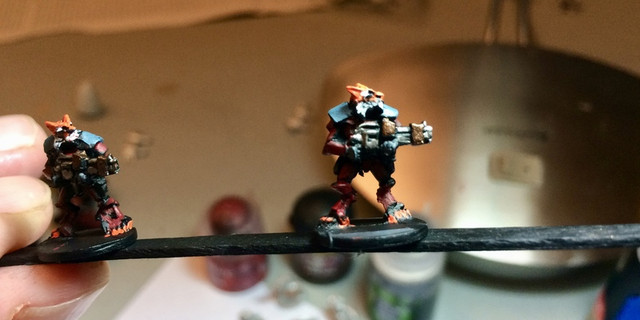
Khurasan offers a trio of jet-bike riders, so that was irresistible. The idea of fast attack cats seemed very Kzinti, so I ordered three sets, which will give me a respectable recon and fast attack element to my force. I would imagine that the youngest and most aggressive warriors would be selected for this hazardous and dangerous job. These chaps aren’t quite finished but are getting there.
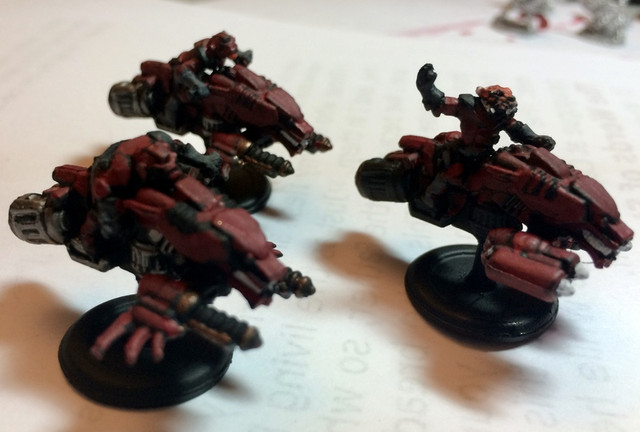
Space Kitty Bike Leader looks like the sort of type who would happily buzz the tower. He has some very aggressive looking missile pods that should prove helpful.
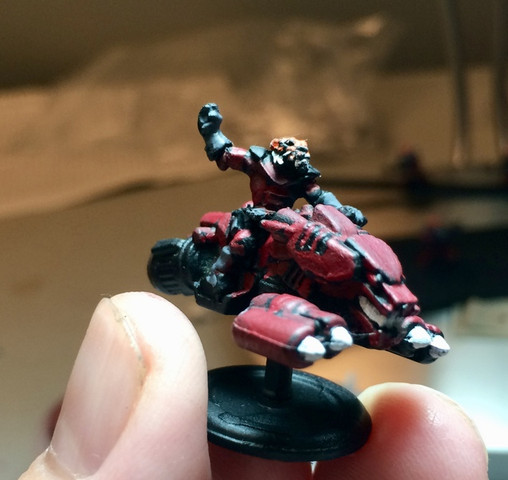
Finally, there is a an armoured component to my force, because who is going to drive across the galaxy to invade a bunch of high-tech monkeys without some decent AFV support? I also ordered a few vehicles from Ground Zero Games from their line of Kra’vak alien vehicles. This is one of three anti-gravy APCs which will carry a section each of my light infantry. Again, a red base coat, but I have a pattern for it which should make it look more menacing. The little blue swatch on the side is to remind me which section it belongs to. There is also a tank, a SPG, a pair of drones, a pair of skimmer light attack craft, and a smallish spaceship to debut down the road. The base is from a GW W40K set of Ork Deffkoptas that I have since gotten rid of. This project is much more serious!

I will show more of my progress soon, I hope. For those of you who are wondering, the rules we are using are mostly a bodge of James’ devising, very simple. We hope to get our forces in action sometime by late winter or spring.
Blessings to your brushes!
MP
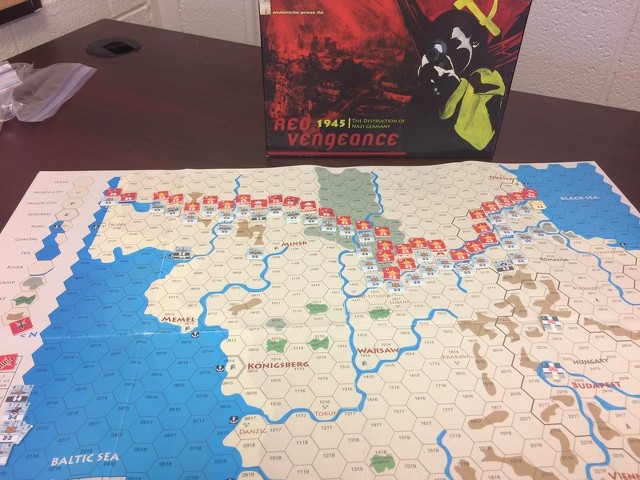



Hello friends!
As I mentioned in my previous post, my partner Joy is very much a dog person. In her life she’s owned several pure-bred huskies, and we occasionally talk about getting a husky puppy when I retire in a few years, though there are all sorts of pros and cons there.

Joy with war dog statue near Ottawa City Hall, June 2018
Joy is not much of a wargames person, but she does appreciate a crossover angle, like my friend Jame’s goblin wolf riders in my last post.
I don’t remember how, but I came across a crazy Kickstarter project called Dungeons and Doggies. The idea is that various breeds of dogs decide to become D&D characters and set off, appropriately acquired, for the local dungeon. How that is any more ridiculous than, say, a giant floating eyeball?

How do they draw their swords? They don’t have thumbs!!!!?????
The KS project does include a paladin husky dog wearing armour, which painted would make a lovely gift for herself. Lord knows what I’ll do with the rest of them, but I know enough doglovers that individual figures will make nice gifts. I am a bit leery of Kickstarter projects generally, but this one is fully funded and then some, so hopefully it will deliver.
Blessings to your doggos!
MP
Hello all:
I was totally bowled over by all the support that I received on my last post, where I resumed blogging after my wife’s death last winter. Thank you all so much. It’s been a few months since then, so a little catch up. Back in May I said here that “A lovely lady, a cancer widow, has entered my life and made it much richer”. Well, “much richer” barely describes half of it. Her name is Joy, and she is well-named.
I met her through the Anglican parish where I serve as a volunteer assistant priest. Her husband was being treated for cancer at the same hospital where Kay was a frequent flyer, so we often crossed paths and would meet for coffee and mutual encouragement, telling the war stories that only caregivers can really understand. Then, last November, mysteriously and ten days apart, first Randy died, then Kay. That winter was hard, but we got through it, checking in and feeding each other as necessary, and gradually realizing that life, and love, can go on.

In April we celebrated Joy’s birthday with a trip to Mexico. On the flight home, we talked about how difficult it was visiting each other’s houses with a dog and three cats in the equation, and so high above the Gulf of Mexico we decided to throw in together.

It was a splendid decision, and looking back on it, totally the right one. We weren’t expecting to find love so quickly, but as is the case with a long terminal illness, we had both been in mourning for a year before our spouses passed, and coming back into the land of the living was an unexpected blessing. As C.S. Lewis said in another context, I was truly Surprised by Joy.
As I moved into Joy’s house, she was a little dismayed at what came with me. Most of my furniture I left for the tenants of my house to enjoy, but I did bring a steady stream of boxes full of games, terrain, and little soldiers. She was a good sport, even as she lamented how her basement was now overrun with things that she didn’t truly understand, but she did appreciate the paintwork on my “little men”.
In late May, a bemused Joy had the chance to see some of my collection set up on her dining room table when my mate James came up the three hours from Stratford for one of our ongoing EX THUNDERING DICE dustups. We don’t see each other as much as we’d like, so we try to get a lot out of our EX TD weekends. Here the hordes of Middle Earth prepare to do battle - I think we each used about 40 points of figures using our favourite quick play fantasy rules, Dragon Rampant.
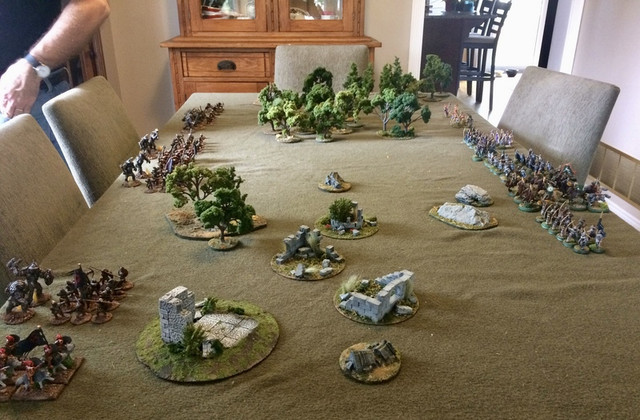
I love James’ work, and am always curious to see his latest units. That day he debuted this impressive unit of wolf riders, old Vendel figures, with a handprinted banner of little doggies circling the Eye of Mordor. Joy, who adores husky dogs, was suitably impressed.
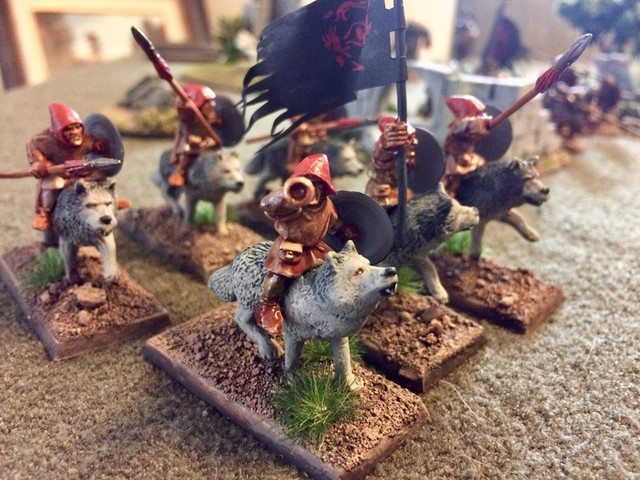
Much mayhem occurred that day, and while the Wolf Riders died in the end, they were a right pain in the arse. Even when they were reduced to one figure, they tied up my Rohirrim cavalry and were generally annoying. Good doggies.
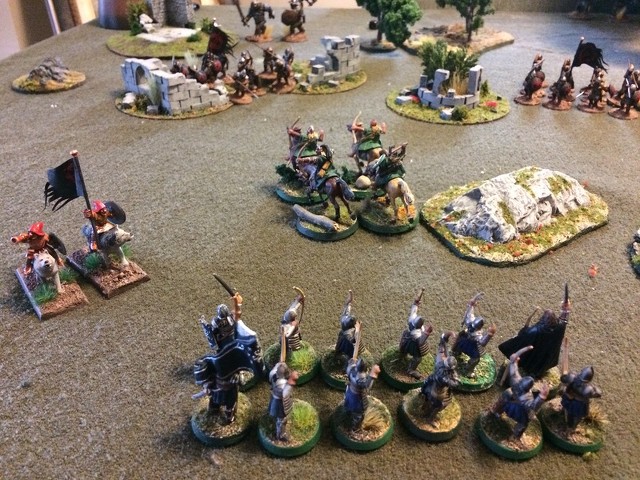
James has some more pictures here. Also that weekend, I tried to introduce James to one of my fav GMT games, Space Empires, but I think it was all a bit much for him. On Saturday we decided to play TFL’s Sharp Practice, but the unpacking was still in progress and since I couldn’t find my ACW figures, we used my SYW figures, Russians versus Turks. It made me realize how much I enjoyed this period, and how much I would like to get back into it.
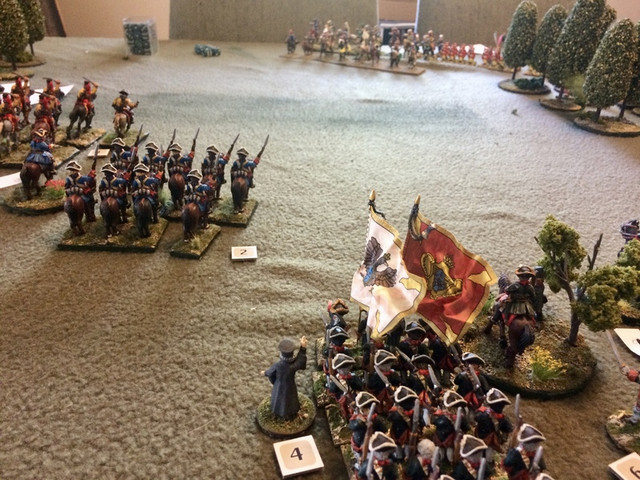
Joy and I spent a lot of time together this summer, solidifying our relationship, and everyone we know says we just look like a pair of happy idiot kids, so that bodes well, I think.
There was a little more gaming, and I’ll tell you some more about that sometime. Oh yes, there is a project involving Space Kitties. More to follow.
Blessings to all of you in the land of the living.
MP